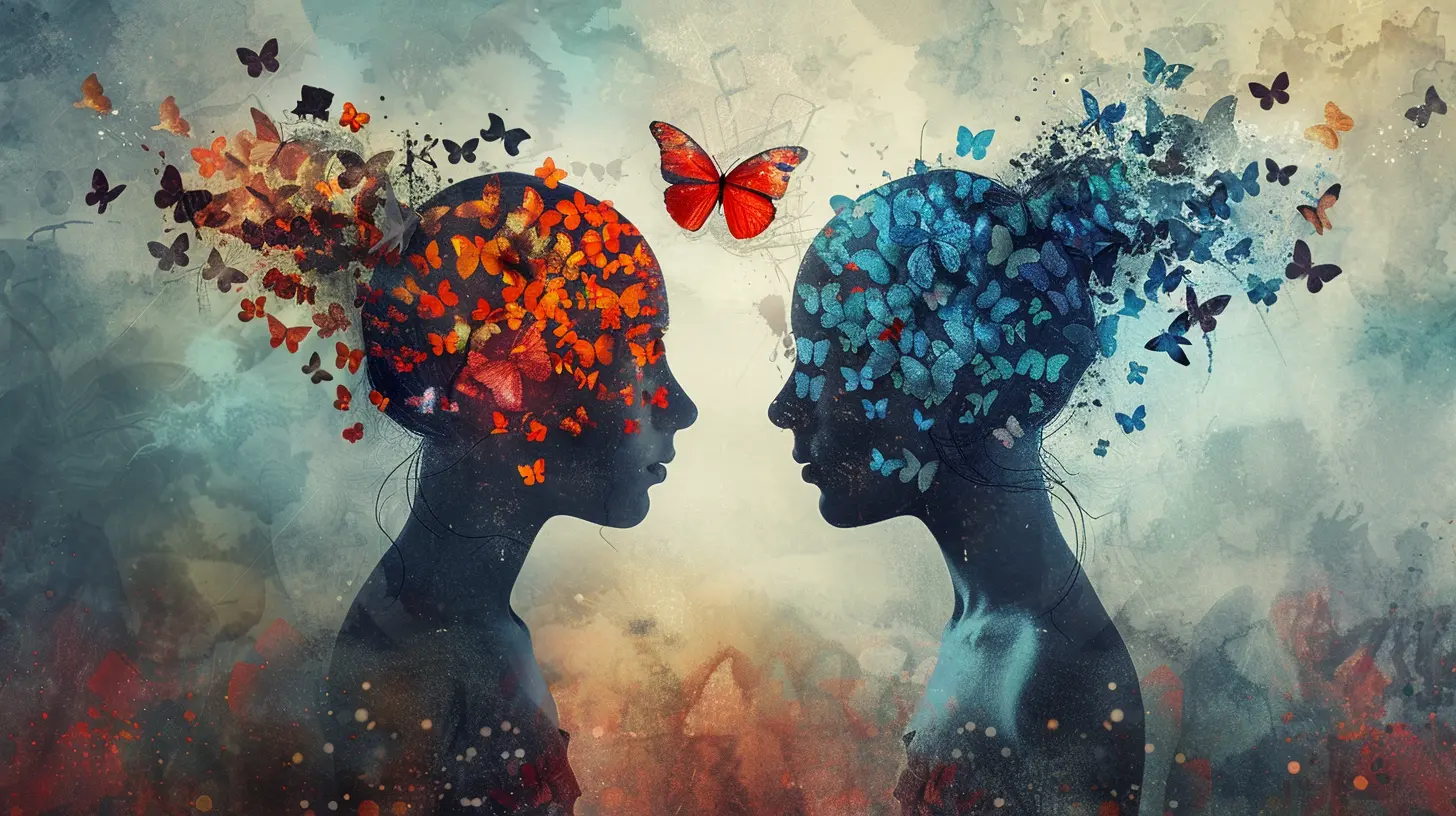The Role of Attachment in Mental Health Disorders
27 July 2025
Let’s talk about something we all crave, whether we admit it or not—connection. You know that warm fuzzy feeling you get when your best friend remembers your birthday, or that gut-wrenching ache when someone ghosts you? That’s your attachment system kicking in. And oh boy, it’s a powerful force.
But here's the kicker: the way we form attachments—starting from our earliest relationships with caregivers—can shape our emotional blueprint for life. No pressure, mom and dad!
So today, we’re diving headfirst into the fascinating world of attachment and its link to mental health disorders. Buckle up, because attachment theory isn’t just psychobabble—it’s the backstage pass to understanding why we sometimes feel and act the way we do.

What Is Attachment, Anyway?
Alright, let’s break down the basics first.Attachment is a deep emotional bond between two people, typically between a child and their primary caregiver. Think of it as the internal GPS that helps you navigate relationships throughout your life.
It was first cooked up by the legendary psychologist John Bowlby, who believed that a secure attachment in infancy leads to healthier emotional development. Then came Mary Ainsworth, who added a dash of spice with her “Strange Situation” experiments, observing how babies reacted when left alone or reunited with their caregivers.
But here's where things get really juicy—there’s not just one kind of attachment. Nope. There are a few different flavors, and each one has its own baggage.
The Four Attachment Styles
Let’s meet the crew:1. Secure Attachment – The golden child of attachment styles. These folks are comfortable with closeness and independence. They trust easily and handle stress like champs.
2. Anxious Attachment – These individuals live in emotional suspense. Think clingy, needy, and constantly afraid that people will leave them.
3. Avoidant Attachment – Distant and emotionally armored. They keep people at arm’s length and pride themselves on self-sufficiency.
4. Disorganized Attachment – This one’s a rollercoaster. It’s a chaotic mix of avoidance and anxiety, often born from trauma or abuse.
Each style reflects how we deal with stress, intimacy, and conflict—and guess what? They can massively impact our mental health.

So, How Does Attachment Mess With Our Minds?
Let’s be real—nobody escapes childhood unscathed. But for some, attachment wounds run deep and can interfere with emotional regulation, relationships, and even identity. These issues don’t just disappear; they can morph into full-blown mental health disorders if left unaddressed.Here’s how the dots connect.
1. Anxiety Disorders and Anxious Attachment: A Match Made in Nervous-System Heaven
If your childhood was filled with inconsistency—sometimes your caregiver was loving, other times emotionally unavailable—you might grow up with anxious attachment.This style can fuel an internal storm where fear of abandonment meets chronic worry. It’s like your brain is always scanning for the next emotional earthquake.
Symptoms may include:
- Constant overthinking about relationships
- Fear of being unloved or rejected
- Panic attacks or generalized anxiety
Sound familiar? This kind of attachment can lay the groundwork for disorders like Generalized Anxiety Disorder (GAD) or Panic Disorder.
2. Avoidant Attachment and Depression: The Lone Wolf's Dilemma
Avoidant types often pride themselves on not needing anyone—but let’s be honest, that’s a lonely hill to die on.These individuals usually suppress emotions and struggle to connect with others deeply. Over time, this emotional bottling can lead to depression, because let’s face it—humans aren’t meant to fly solo emotionally.
Avoidant attachment can contribute to:
- Emotional numbness
- Feelings of emptiness and disconnect
- Low self-worth
It’s ironic, really. In avoiding pain, they end up creating more of it.
3. Disorganized Attachment and PTSD: When Chaos Breeds Chaos
Disorganized attachment often stems from early trauma, neglect, or abuse. These individuals might fear intimacy but also crave it—creating a confusing push-pull dynamic.This chaos sets the stage for disorders such as:
- Post-Traumatic Stress Disorder (PTSD)
- Complex PTSD (C-PTSD)
- Even Borderline Personality Disorder (BPD)
These folks often experience intense mood swings, unstable relationships, and a fractured sense of identity.
Their inner world? Think emotional ping-pong played with flaming paddles.
4. Eating Disorders and Attachment Wounds: Comfort in Control
Sometimes, when people can’t control their emotional world, they try to control their physical one. Cue the development of eating disorders like Anorexia Nervosa or Binge Eating Disorder.Insecure attachment—especially anxious or disorganized—can lead to a rocky relationship with food. It becomes a tool for coping, a way to self-soothe, or even a method of rebellion.
It’s not about the food—it’s the feeling of safety (or the lack thereof).

Can Your Attachment Style Change?
Here’s the good news: your brain’s not set in stone. No matter what kind of attachment style you’ve been rocking since childhood, change is possible. It’s called earned secure attachment.How? Let healthy relationships, therapy, and good ol’ self-awareness work their magic.
The Role of Therapy
Therapies that focus on attachment include:- Attachment-Based Therapy
- Emotion-Focused Therapy (EFT)
- Trauma-Informed Therapy
- Internal Family Systems (IFS)
Therapists trained in these approaches can help you identify your attachment style, connect the dots to present-day struggles, and develop healthier relational habits.
It’s kind of like emotional CrossFit—painful, sweaty, but totally worth it.
Relationships As A Healing Ground
Ironically, the very thing that caused the wound (relationships) is also the medicine. Safe, respectful, and loving relationships can rewire your emotional circuitry.Think of it like emotional physiotherapy. You’re training your brain to trust, open up, and feel okay being vulnerable.

Parenting, Attachment, And Future Mental Health
Yup, it all begins with parenting. But before you go calling your mom and blaming her for that weird obsession with texting your ex—hold up.Parents do shape attachment styles, but they’re not the whole story. Genetics, environment, and later-life relationships also play a role.
However, emotionally attuned parenting—where a caregiver responds consistently and lovingly—creates secure attachments and lowers the risk of future mental health issues.
So if you’re a parent (or plan to be), focus on bonding, listening, and being emotionally available. You don’t need to be perfect—just consistent.
Attachment in Adult Life: It's Not Just About Mom Anymore
Attachment isn’t just for kids. Nope—it follows us into adulthood like a clingy cat.In romantic relationships, friendships, and even workplace dynamics, your attachment style can influence how you deal with stress, conflict, and connection.
Ever dated someone who ghosted after things got serious? They might be avoidantly attached. Got a friend who checks in 12 times a day and spirals if you don’t reply in 10 minutes? Hi anxious attachment!
The point is, adult relationships are a mirror reflecting your earliest connections. The key is to recognize the patterns and respond, not react.
Red Flags and Green Lights: How Attachment Styles Show Up
Red Flags:- Fear of abandonment
- Emotional withdrawal
- Extreme jealousy
- Difficulty trusting others
- Having no boundaries—or way too many
Green Lights (aka signs of a secure attachment):
- Clear communication
- Healthy boundaries
- Comfort with closeness and independence
- Emotional regulation
- Trust and mutual respect
If you’re nodding at the red flags—don’t panic. Becoming aware of them is step one. Healing doesn’t mean achieving perfection; it means moving toward emotional balance.
Final Thoughts: Your Attachment Style Isn’t a Life Sentence
So here’s the takeaway: your attachment style might explain a lot about your mental health struggles, but it doesn’t define your future. It’s the script you were handed—but that doesn’t mean you can’t rewrite it.Awareness is power. With the right tools, relationships, and support, it’s entirely possible to move toward secure attachment and better mental health.
And hey, next time someone tells you they have “trust issues”? Maybe cut them some slack. Odds are, their inner child has been hurt before.
So go ahead—call your therapist, open up to a loved one, or even just journal about your relationships. Healing begins with understanding, and now? You’ve got a pretty solid head start.
all images in this post were generated using AI tools
Category:
Attachment TheoryAuthor:

Paulina Sanders
Discussion
rate this article
1 comments
Vito Ramirez
Understanding attachment styles is crucial in addressing mental health disorders and promoting effective therapeutic interventions for lasting recovery.
August 25, 2025 at 3:26 AM

Paulina Sanders
Thank you for highlighting the importance of attachment styles! They indeed play a vital role in shaping our mental health and guiding effective therapeutic approaches.


